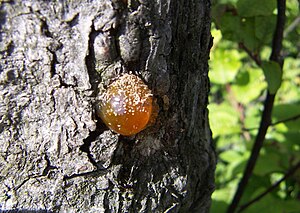Informatics Educational Institutions & Programs
Contents

Natural gums are polysaccharides of natural origin, capable of causing a large increase in a solution's viscosity, even at small concentrations. They are mostly botanical gums, found in the woody elements of plants or in seed coatings.
Human uses
Gums are used in the food industry as thickening agents, gelling agents, emulsifying agents, and stabilizers, and in other industrial adhesives, binding agents, crystal inhibitors, clarifying agents, encapsulating agents, flocculating agents, swelling agents, foam stabilizers, etc. When consumed by humans, many of these gums are fermented by the microbes that inhabit the lower gastrointestinal tract (microbiome) and may influence the ecology and functions of these microscopic communities.[1][2]
Commercial significance
Humans have used natural gums for various purposes, including chewing and the manufacturing of a wide range of products - such as varnish and lacquerware. Before the invention of synthetic equivalents, trade in gum formed part of the economy in places such as the Arabian peninsula (whence the name "gum arabic"), West Africa,[3] East Africa (copal) and northern New Zealand (kauri gum).
Examples
Natural gums can be classified according to their origin. They can also be classified as uncharged or ionic polymers (polyelectrolytes). Examples include (with E number food additive code):
| Source | Classification | Natural gum | E number | biological origin |
|---|---|---|---|---|
| obtained from seaweeds | Polyelectrolytes | Agar | E406 | |
| obtained from seaweeds | Polyelectrolytes | Alginic acid | E400 | |
| obtained from seaweeds | Polyelectrolytes | Sodium alginate | E401 | |
| obtained from seaweeds | Polyelectrolytes | Carrageenan | E407 | |
| obtained from non-marine botanical resources | Polyelectrolytes | Gum arabic | E414 | from the sap of Acacia trees |
| obtained from non-marine botanical resources | Polyelectrolytes | Gum ghatti | from the sap of Anogeissus trees | |
| obtained from non-marine botanical resources | Polyelectrolytes | Gum tragacanth | E413 | from the sap of Astragalus shrubs |
| obtained from non-marine botanical resources | Polyelectrolytes | Karaya gum | E416 | from the sap of Sterculia trees |
| obtained from non-marine botanical resources | Uncharged | Guar gum | E412 | from guar beans |
| obtained from non-marine botanical resources | Uncharged | Locust bean gum | E410 | from the seeds of the carob tree |
| obtained from non-marine botanical resources | Uncharged | Beta-glucan | from oat or barley bran | |
| obtained from non-marine botanical resources | Uncharged | Dammar gum | from the sap of Dipterocarpaceae trees | |
| obtained from non-marine botanical resources | Uncharged | Glucomannan | E425 | from the konjac plant |
| obtained from non-marine botanical resources | Uncharged | Psyllium seed husks | from the Plantago plant | |
| obtained from non-marine botanical resources | Uncharged | Tara gum | E417 | from the seeds of the tara tree |
| produced by bacterial fermentation | Polyelectrolytes | Gellan gum | E418 | |
| produced by bacterial fermentation | Polyelectrolytes | Xanthan gum | E415 |
References
- ^ Hehemann, Jan-Hendrik; Kelly, Amelia G.; Pudlo, Nicholas A.; Martens, Eric C.; Boraston, Alisdair B. (27 November 2012). "Bacteria of the human gut microbiome catabolize red seaweed glycans with carbohydrate-active enzyme updates from extrinsic microbes". Proceedings of the National Academy of Sciences. 109 (48): 19786–19791. Bibcode:2012PNAS..10919786H. doi:10.1073/pnas.1211002109. PMC 3511707. PMID 23150581.
- ^ Ostrowski, Matthew P.; La Rosa, Sabina Leanti; Kunath, Benoit J.; Robertson, Andrew; Pereira, Gabriel; Hagen, Live H.; Varghese, Neha J.; Qiu, Ling; Yao, Tianming; Flint, Gabrielle; Li, James; McDonald, Sean P.; Buttner, Duna; Pudlo, Nicholas A.; Schnizlein, Matthew K.; Young, Vincent B.; Brumer, Harry; Schmidt, Thomas M.; Terrapon, Nicolas; Lombard, Vincent; Henrissat, Bernard; Hamaker, Bruce; Eloe-Fadrosh, Emiley A.; Tripathi, Ashootosh; Pope, Phillip B.; Martens, Eric C. (April 2022). "Mechanistic insights into consumption of the food additive xanthan gum by the human gut microbiota". Nature Microbiology. 7 (4): 556–569. doi:10.1038/s41564-022-01093-0. hdl:11250/3003739. PMID 35365790. S2CID 247866305.
- ^
Wiseman, Nicholas Patrick, ed. (1838). "The French in Africa". The Dublin Review. 4 (7). London: Tablet Publishing Company: 188, 189.
Rivalries of a commercial nature have necessarily existed between the British and French merchants on [the West African] coast, especially with reference to the trade in gum, which is very lucrative, yielding very commonly returns not much under cent per cent. [...] Ġum is, in fact, an article with which the chief manufacturers of England and france cannot well dispense. It is used in almost every process of dyeing, in the printing of cottons, in the fabrication of silks, ribbons, lawns, gauzes, cambrics, and hats. It is frequently an ingredient in medical and confectionary preparations; it enters into the composition of colours for painters; it is necessary to the varnisher and gilder, and a great variety of other artizans. It was formerly obtained only from Arabia, whence it was imported into France by the way of Marseilles, and through France to England and all Europe. The Dutch, however, in their intercourse with the African Moors, discovered that they had forests in the desert of Sahara which produced gum in abundance. [...] Upon examination, the Dutch found that the African gum was of a purer and more mucilaginous quality than even that of Arabia. Hence it soon became a most desirable article of commerce [...].

















